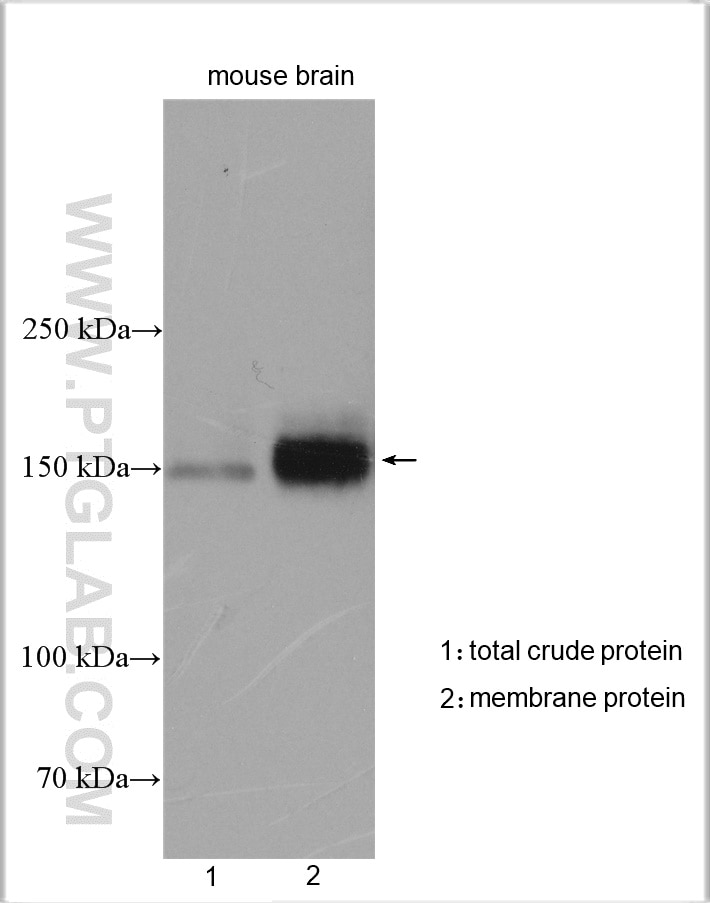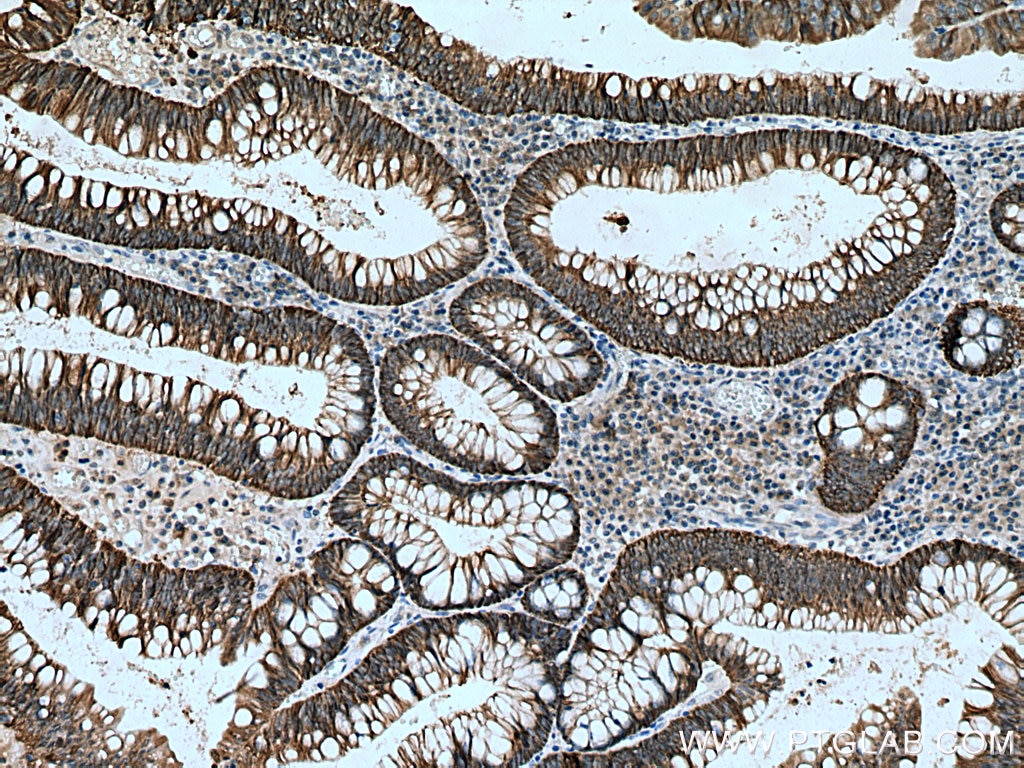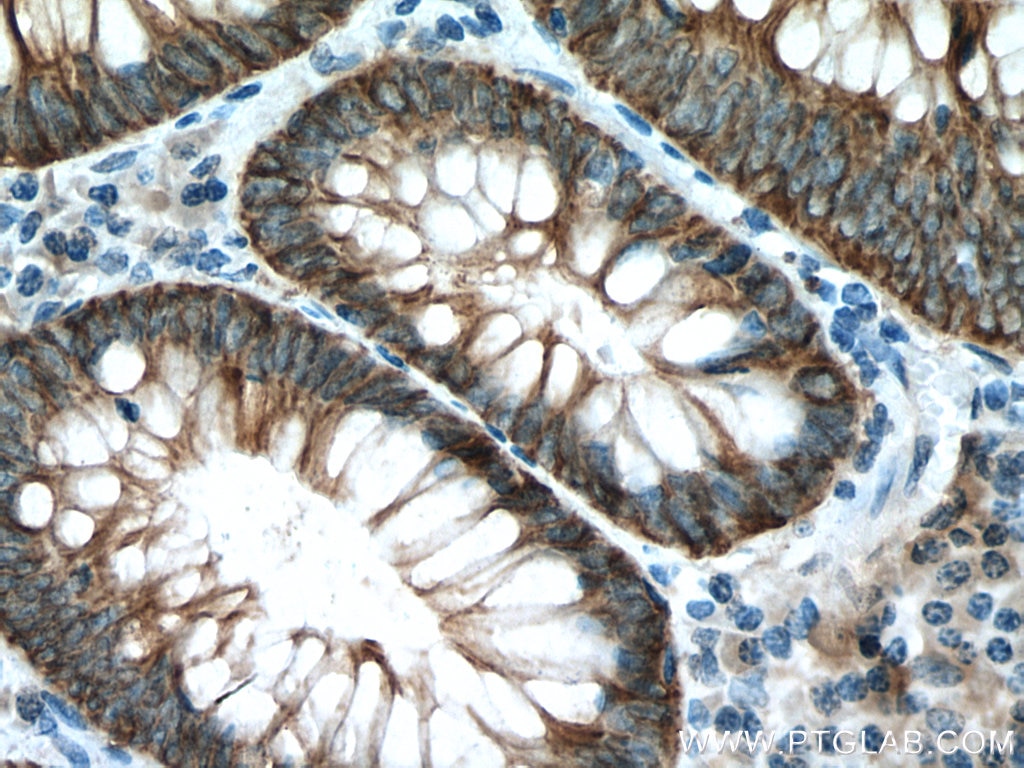- Phare
- Validé par KD/KO
Anticorps Polyclonal de lapin anti-NKCC1,SLC12A2
NKCC1,SLC12A2 Polyclonal Antibody for WB, IHC, ELISA
Hôte / Isotype
Lapin / IgG
Réactivité testée
Humain, rat, souris et plus (1)
Applications
WB, IP, IF, IHC, ELISA
Conjugaison
Non conjugué
N° de cat : 13884-1-AP
Synonymes
Galerie de données de validation
Applications testées
| Résultats positifs en WB | tissu cérébral de souris, tissu cérébral de souris incubé à 37 °C |
| Résultats positifs en IHC | tissu de cancer du côlon humain, il est suggéré de démasquer l'antigène avec un tampon de TE buffer pH 9.0; (*) À défaut, 'le démasquage de l'antigène peut être 'effectué avec un tampon citrate pH 6,0. |
Dilution recommandée
| Application | Dilution |
|---|---|
| Western Blot (WB) | WB : 1:1000-1:4000 |
| Immunohistochimie (IHC) | IHC : 1:50-1:500 |
| It is recommended that this reagent should be titrated in each testing system to obtain optimal results. | |
| Sample-dependent, check data in validation data gallery | |
Applications publiées
| KD/KO | See 2 publications below |
| WB | See 11 publications below |
| IHC | See 9 publications below |
| IF | See 8 publications below |
| IP | See 1 publications below |
Informations sur le produit
13884-1-AP cible NKCC1,SLC12A2 dans les applications de WB, IP, IF, IHC, ELISA et montre une réactivité avec des échantillons Humain, rat, souris
| Réactivité | Humain, rat, souris |
| Réactivité citée | rat, Humain, porc, souris |
| Hôte / Isotype | Lapin / IgG |
| Clonalité | Polyclonal |
| Type | Anticorps |
| Immunogène | NKCC1,SLC12A2 Protéine recombinante Ag4991 |
| Nom complet | solute carrier family 12 (sodium/potassium/chloride transporters), member 2 |
| Masse moléculaire calculée | 131 kDa |
| Poids moléculaire observé | 150-160 kDa |
| Numéro d’acquisition GenBank | BC033003 |
| Symbole du gène | NKCC1/SLC12A2 |
| Identification du gène (NCBI) | 6558 |
| Conjugaison | Non conjugué |
| Forme | Liquide |
| Méthode de purification | Purification par affinité contre l'antigène |
| Tampon de stockage | PBS avec azoture de sodium à 0,02 % et glycérol à 50 % pH 7,3 |
| Conditions de stockage | Stocker à -20°C. Stable pendant un an après l'expédition. L'aliquotage n'est pas nécessaire pour le stockage à -20oC Les 20ul contiennent 0,1% de BSA. |
Informations générales
The Na-K-Cl cotransporter sodium-potassium-chloride cotransporter 1 (NKCC1), encoded by the SLC12A2 gene, is an intensively studied member of the CCC family. NKCC1 is a membrane protein and plays fundamental roles in regulating trans-epithelial ion movement, cell volume, chloride homeostasis and neuronal excitability. NKCC1 assembles into a dimer, with the first ten transmembrane (TM) helices harboring the transport core and TM11-TM12 helices lining the dimer interface(PMID: 32081947). The observed molecular weight of NKCC1 is about 140 kDa, glycosylated NKCC1 is detected a band at ∼170 kDa (PMID: 22723696).
Protocole
| Product Specific Protocols | |
|---|---|
| WB protocol for NKCC1,SLC12A2 antibody 13884-1-AP | Download protocol |
| IHC protocol for NKCC1,SLC12A2 antibody 13884-1-AP | Download protocol |
| Standard Protocols | |
|---|---|
| Click here to view our Standard Protocols |
Publications
| Species | Application | Title |
|---|---|---|
PLoS Biol Early uneven ear input induces long-lasting differences in left-right motor function. | ||
PLoS Biol The NKCC1 ion transporter modulates microglial phenotype and inflammatory response to brain injury in a cell-autonomous manner. | ||
J Neurosci The severity of vestibular dysfunction in deafness as a determinant of comorbid hyperactivity or anxiety. | ||
Front Mol Neurosci Unilateral optogenetic kindling of hippocampus leads to more severe impairments of the inhibitory signaling in the contralateral hippocampus | ||
Sci Rep Comprehensive analyses of solute carrier family members identify SLC12A2 as a novel therapy target for colorectal cancer
|
Avis
The reviews below have been submitted by verified Proteintech customers who received an incentive forproviding their feedback.
FH Valentina (Verified Customer) (02-01-2023) | Multiple bands were detectable around 100 - 150 kDa, with different protocols and gels. The antibody is definitely working even if not optimally, probably necessary to try with a higher dilution and a lower amount of protein.
|




